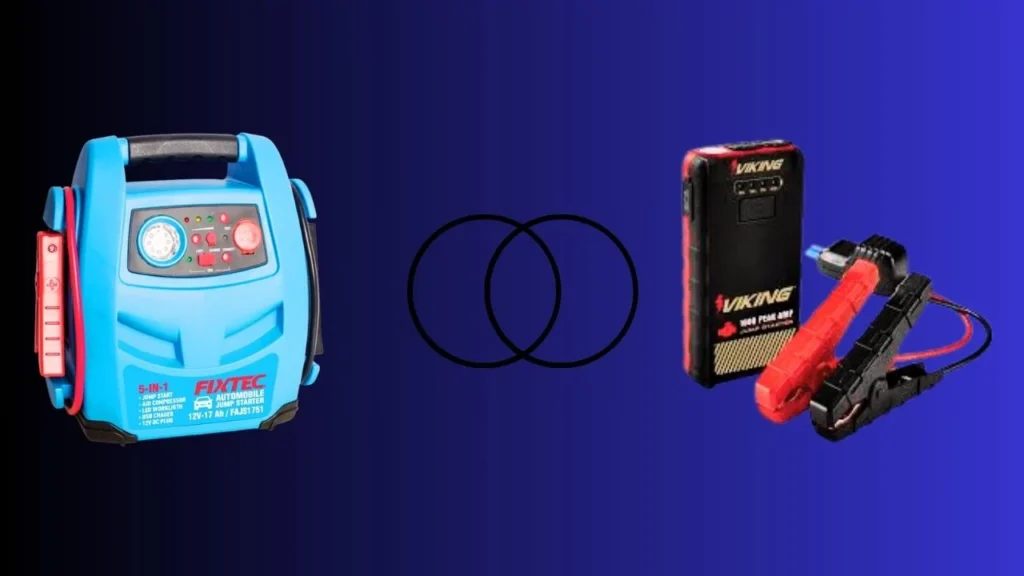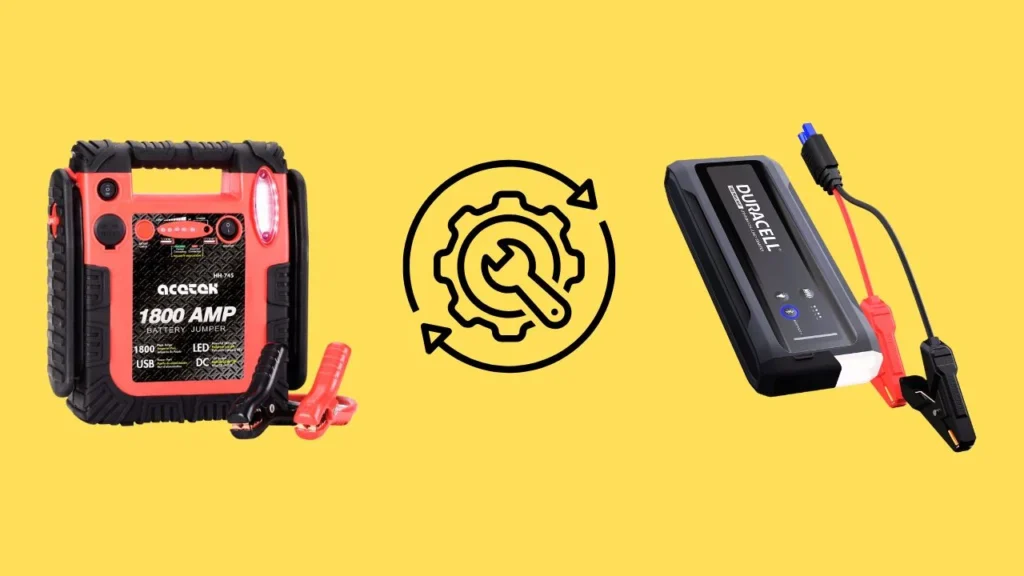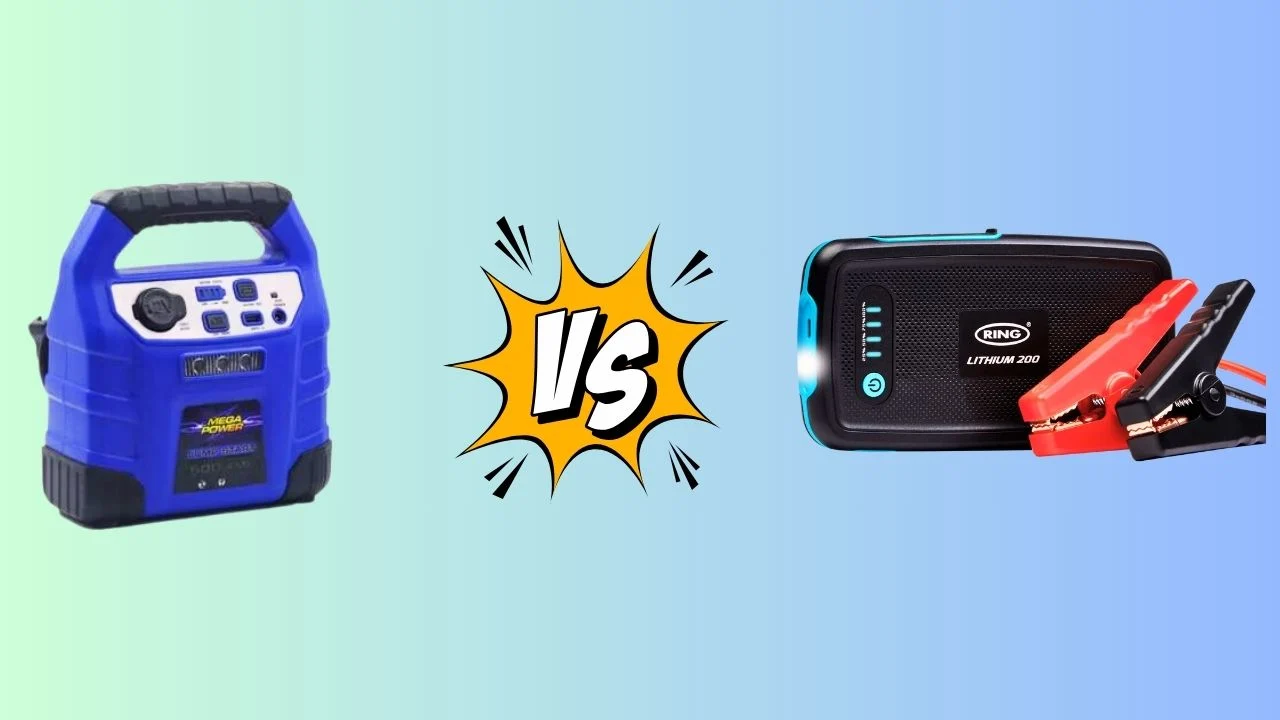I’m stuck with a dead battery, and I need to get moving fast. That’s when I realized how important it is to have the right jump starter especially when choosing between Lead Acid vs. Lithium-Ion Jump Starters. Whether I’m rushing to a meeting or heading out on a road trip, a reliable jump starter is a total lifesaver. With 1 in 5 drivers facing dead batteries each year, being prepared has never been more crucial.Lithium-ion models are 75% lighter and 50% more compact than lead-acid ones but still powerful enough to get me back on the road.
Quick Look
Yes, I’ve been there, stuck with a dead battery and in a rush to get back on the road. In this guide, I’m sharing my experience with both lead-acid and lithium-ion jump starters. While I’ve found lead-acid models to be reliable, they’re heavy and need more maintenance. However, Most Popular Portable Jump Starter options today, especially lithium-ion models, are lighter, more compact, and charge way faster.
How Lead-Acid and Lithium-Ion Batteries Work: Key Differences Explained
Let’s dive into how lead-acid and lithium-ion batteries actually work so you can understand why each might be right for you. Hulkman vs Noco: Jump Starter Showdown gives you a breakdown of the best models available, showcasing the pros and cons of each type and helping you make the best choice based on your needs.
How Lead-Acid Batteries Work?
I’ve always found lead-acid batteries to be pretty reliable. They’re the go-to choice for cars and jump starters because of their long-standing track record. Inside the battery, there are lead plates submerged in a sulfuric acid solution. When I charge the battery, a chemical reaction happens between the lead and the acid, creating electricity to power my vehicle or device.
- Reliable, proven technology
- Heavy and bulky
- Requires maintenance
But here’s the thing I’ve noticed: these batteries can be a bit heavy and bulky. The lead plates take up a lot of space, making them larger than some newer options. And while they do the job well, they need a bit more maintenance.
How Lithium-Ion Batteries Work?
Yes, let’s talk about how lithium-ion batteries work and why they’re a game-changer compared to older options like lead-acid batteries. I’ve always been impressed by how efficient and compact these batteries are. Instead of using sulfuric acid, lithium-ion batteries use lithium salts. When you charge them, lithium ions move through an electrolyte solution, storing energy in the process. This is what makes them lighter, smaller, and able to hold more energy than the older lead-acid batteries.
- Compact, efficient design
- Fast charging, longer lifespan
- Low degradation over time
One thing I really appreciate about lithium-ion batteries is how quickly they charge and how long they last. They’re built for durability and don’t degrade as fast as lead-acid batteries, which is why EV Battery Boosters are gaining popularity in the market for electric vehicles.
Lead Acid vs. Lithium-Ion: Detailed Comparison

Let’s dive into the key differences between lead-acid and lithium-ion jump starters from my own experience. Over the years, I’ve come to appreciate the pros and cons of each, especially after using Lithium Jump Start Boosters for various situations.
Weight and Portability
When I first compared the two, the weight difference hit me right away. Lead-acid jump starters tend to be much heavier, sometimes weighing up to 30 pounds or more.In contrast, lithium-ion models are incredibly lightweight, often weighing as little as 5-10 pounds.
- Lithium-ion: Lightweight, compact
- Lead-acid: Heavy and bulky
This was a game-changer for me, especially when I needed something portable that wouldn’t take up too much space in the car.
Charging Time and Efficiency
Another thing that stood out to me was the charging time. With lead-acid batteries, I’d find myself waiting for hours to get a full charge. It can take around 6-12 hours depending on the size.
On the other hand, lithium-ion jump starters charge way faster, typically around 2-4 hours which means I can quickly get back on the road without wasting time.
Lifespan and Maintenance
The longevity of the jump starter was something I definitely considered. Lead-acid batteries, while reliable, generally start losing their charge capacity after 3-5 years, which means they require more maintenance over time.
Lithium-ion batteries, however, can last much longer around 5-10 years and they don’t require as much upkeep, making them a more hassle-free choice.
Power Output Comparison
In terms of power, I found lithium-ion jump starters surprisingly strong despite their smaller size. They can deliver up to 1,000 peak amps or more, which is more than enough to jump-start most vehicles.
Lead-acid jump starters typically offer slightly higher peak amps, but the difference isn’t huge in real-world use. The power is more consistent with lithium-ion, and that’s something I’ve really come to appreciate.
Similarities Between Lead-Acid and Lithium-Ion Jump Starters
Essential Power for Emergencies
Yes, both lead-acid and lithium-ion jump starters provide that critical power needed to get your vehicle or device running again. Whether it’s for a car, truck, or motorcycle, I’ve found that both types are designed to give you that quick boost when you’re in a bind.
Safety Features You Can Trust
I’ve noticed that both types come equipped with essential safety features, like overcharge protection and temperature monitoring. These features help ensure that I can use the jump starter with confidence, without worrying about overusing it or overheating while in action.
Versatile and Multi-Purpose
No matter the type, both lead-acid and lithium-ion jump starters are versatile enough to handle a variety of vehicles and devices. From my experience, they work just as well for motorcycles as they do for larger trucks or equipment, so you can count on them when you need a reliable power boost.
Which One is Right for You?
How Often Will You Use It?
When I was making my decision, the first thing I thought about was how often I actually needed a jump starter. If you’re like me and find yourself needing one 3-4 times a year or more, then you’ll likely appreciate the convenience of a lithium-ion jump starter. They’re quick to charge and easy to use, making them perfect for frequent use.
Portability and Storage
For me, portability was a big deal. Lithium-ion models are up to 75% lighter and 50% more compact than lead-acid versions, which made it so much easier to store in my car without taking up much space. If you’re often on the move, this could be a game-changer for you too.
Budget Considerations
If budget is a bigger concern for you and you don’t mind the extra weight, lead-acid jump starters are a solid option. They’re typically more affordable and still reliable for those who need a jump starter just once or twice a year. You’ll get the job done without breaking the bank.
Your Final Choice
Ultimately, it all comes down to your personal needs. If you want something compact, fast-charging, and easy to carry around, go for lithium-ion. But if you’re on a budget and don’t mind the bulk, a lead-acid jump starter could still be the right choice for you. Whatever you choose, just be sure you have one on hand so you’re always ready to hit the road.
Maintenance: Lead-Acid vs. Lithium-Ion Jump Starters

- When it comes to maintenance, lead-acid jump starters need more attention and care. You’ll have to check the acid levels regularly, keep them charged to ensure they’re ready when needed, and clean the terminals and connections every so often to prevent corrosion. This type of jump starter requires more hands-on upkeep to keep it functioning optimally, making it less ideal for those who prefer a low-maintenance option.
- In contrast, lithium-ion jump starters are incredibly low-maintenance. They hold their charge for much longer periods and don’t require checking acid levels or cleaning terminals. These batteries are designed to be “set it and forget it,” providing a hassle-free experience with minimal upkeep. If you prefer convenience and efficiency, a lithium-ion jump starter is an excellent choice, offering more reliability with less attention needed over time.
Conclusion
After comparing lead-acid vs. lithium-ion jump starters, I’ve found that lead-acid jump starters are reliable and get the job done, but they’re bulky and need more maintenance. They’re a great option if weight isn’t a concern. On the other hand, lithium-ion jump starters are up to 75% lighter and 50% more compact, charging faster and lasting 3-5 years longer than lead-acid models.
Personally, I prefer the portability and convenience of lithium-ion, especially when I’m always on the move. Whether you choose lead-acid or lithium-ion, having a jump starter ready is crucial. It’ll save you time and hassle when you need it most.
FAQs:
Q1. What’s the difference between lead-acid and lithium-ion jump starters?
Lead-acid jump starters are heavier and bulkier, requiring more maintenance, while lithium-ion jump starters are lighter, more compact, and offer quicker charging with minimal upkeep. The choice depends on whether you prioritize power and reliability or portability and convenience.
Q2. How long do lithium-ion jump starters last compared to lead-acid models?
Lithium-ion jump starters typically last 3-5 years longer than lead-acid models, offering a more durable and long-lasting solution for your jump-starting needs.
Q3. Are lead-acid jump starters more maintenance-heavy than lithium-ion models?
Yes, lead-acid jump starters require regular maintenance like checking acid levels and cleaning terminals. Lithium-ion jump starters are much easier to maintain and can go longer without needing attention, making them a more hassle-free option.
Q4. Which jump starter is better for portability?
Lithium-ion jump starters are up to 75% lighter and 50% more compact than lead-acid models, making them the ideal choice for anyone who needs a portable, on-the-go solution.




